
A poster shows the top 10 discoveries of 2023 Photo: Sina Weibo
Nominated by the notable magazine Archaeology, the animal burial pit discovered from the mausoleum that belongs to the Emperor Wendi of the Western Han Dynasty (206BC-AD25) in Xi'an, Shaanxi Province has recently become one of the top ten archaeological discoveries of the world for the year of 2023.
The mausoleum of the Emperor Wendi is also known as Ba mausoleum. Amongst all the other sites that come from countries such as Italy, Peru and Egypt, the Ba mausoleum is the only archaeological spot represents China to have become laurelled.
The animal burial pit was discovered in 2021 alongside the Ba mausoleum, which includes over 100 ancient tombs. These tombs were officially identified for the first time as belonging to Emperor Wendi.
The animal burial pit was found by then as sensation as it includes a total of 11 types of animal remains. The skeleton of a giant panda was discovered to reveal ancient tradition of using precious animals to company the deceased. Aside panda, animals like yak, tiger, tortoise, red-crowned crane and also green peacock have also been found for the first time.
"The scale of the animal sacrifice is unprecedented in Chinese history," said Hu Songmei, an archaeologist of the Shaanxi Academy of Archaeology.
Archaeologist Xue Ruiming told the Global Times that people in the Han dynasty believed that death was still "like life," and people back then had the custom of creating an underground world for their deceased ancestors according to mimic their living environment when they were alive.
Located in Jiangcun Village on the outskirts of Xi'an, the mausoleum of the Emperor Wendi was first excavated in the years of 1960s and 1970s.



